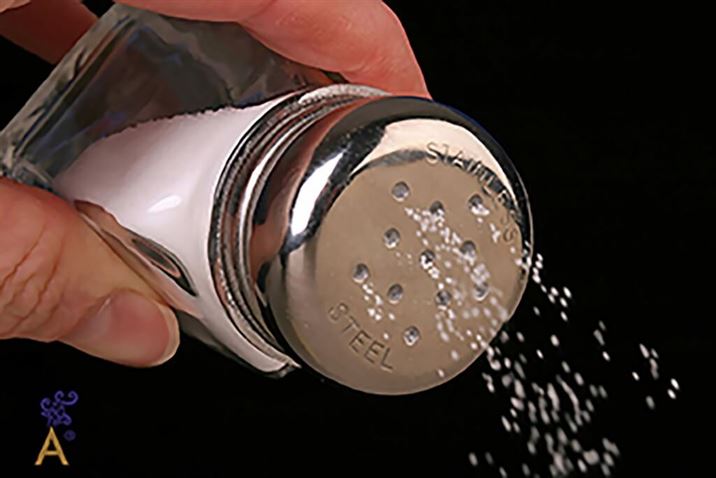Salt is a substance within reach of most people. It is a compound that has been in existence since man. It is an ingredient that not only enhances flavors, but has medicinal, spiritual, political and economic properties.
Salt is a mineral composed primarily of two elements: sodium (Na) and chloride (Cl). It is found in great abundance in the oceans and in underground deposits left by seas or primitive lakes. As a result, salt can only be obtained from water through an evaporation process or by mining rock deposits. There are different varieties of salt and even colors. Depending on the place of extraction, the quality can also vary.
Life on earth would not be possible without salt. In fact, every one of us has four to eight ounces of salt in our bodies. Salt is essential for the heart to beat properly, helps to maintain normal blood volume, maintains correct water balance in cells and tissues and also has an important role in the digestion of food.
Many things may be missing in a kitchen, but not surprisingly, salt. In ancient times, salt was as valuable as gold. It was even used as payment to soldiers in Rome. The word “salary” (salarium argentum) is derived from the word salt. Salt has led the way in world history at different times. It has affected economies, politics, traditions, culture and the way of cooking in different civilizations.
Initially, it was not a condiment. It was used rather as a preservative. Through observation, the Chinese, among others, realized that salt could preserve a dead body, food and also act as a cure. The great transoceanic voyages would not be possible without the presence of precious salt. It helped in the preservation of food and prevented the spread of bacteria through moisture.
We can certainly say that the discoveries of distant lands (such as spices routes) and the territorial division of the world would not have been possible without the existence of salt.
la-sal-026-08
The ancient Egyptians used salt in their religious ceremonies and in the mummification process. Salt in ancient Greece was used to buy slaves, hence the phrase “Not worth his salt.”
There are over 30 references to the word salt in the Holy Bible. Lot’s wife in the Old Testament became a pillar of salt. In the New Testament, Jesus referred to his disciples as “the salt of the earth.”
Other religions use salt in their rituals. In Buddhism, salt chases away evil spirits. Before entering a place, Buddhists dust their shoulders with salt after attending a funeral. In Japan, sumo wrestlers scatter salt to purify the ring area. (It is also a good way to kill bacteria.) The Dalai Lama was buried sitting on a bed of salt.
la-sal-026-06
On March 12th 1930, Gandhi began the illegal production of salt by evaporating seawater in India, then a British colony. It was a nonviolent protest against the monopoly and levies on the production of salt exercised by England at the time. The English had taken over the production of salt. After a walking tour of nearly 250 miles, Gandhi arrived at the coast of the Indian Ocean and picked up a pinch of salt. His example was followed throughout the country. People began to evaporate water and collect the salt defying the British who had not failed to assess high taxes for this basic, irreplaceable product. With the movement that began with salt, India achieved independence on August 15, 1947.
The presence of salt is as important in history as it is in the kitchen.
THE SALT MINE IN BAJA CALIFORNIA SUR THAT SUPPLIES SALT TO THE WORLD: Guerrero Ngero – Parallel 28 – Municipality of Mulege
In the state of Baja California Sur, the Guerrero Negro Lagoon, along with the Ojo de Liebre lagoon in the south and Manuela Lagoon to the north, forms the complex called Ojo de Liebre within the Sebastian Vizcaino Bay.
The settlement of Guerrero Negro began in 1954, when an American visionary by the name of Daniel Ludwig decided to satisfy the demand for salt in the United States of America.
[two_first]The salt rimmed the shoreline of the Ojo de Liebre Lagoon. While taking advantage of the resource, he never imagined that one day the company called Exportadora de Sal, SA de CV (ESSA) would become the largest salt mine in the world. Seven million tons of salt per year were exported to the centers of consumption on the Pacific Rim, including Japan, Korea, USA, Canada, Taiwan and New Zealand.
[/two_first][two_second]
ESSA’s objective was the production and export of sea salt for industrial and home use through solar evaporation of seawater.
In 1973, Ludwig sold the company to the Mexican government and Mitsubishi Corporation, 51 percent and 49 percent respectively, resulting in a success story that remains to this day. The company is distinguished not only for its growth and profitability, but also for the treatment of the plant employees.
The next time you put salt in a food, taste a drink with salt or feel the salinity on your lips while swimming in the sea, remember the ancient history of this ingredient and the process it went through before arriving at your table.








